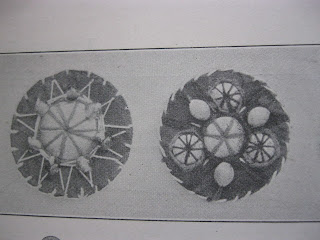The Girls' Friendly Society was founded in England in 1875 by Mary Elizabeth Townsend an Irish Clergyman's daughter.
The girls could join the society aged 12 but in 1882 the age was lowered to 8. the Society was originally set up to protect young working girls, and run almost entirely by women.
By 1880 the society had nearly 40,000 and over 13,500 Associates. Queen Victoria also became the Society's Patron in the same year.
Members benefits included cheap, good quality accommodation for women working in domestic Service, mills and Factory's.
By 1900 the GFS had over 150,00 members and nearly 33,000 Associates in 1,361 branches .
Most members were domestic Service workers but teachers, nurses, clerks, students, and workers in refreshment bars, mills, factories and warehouses were also members.
The society magazine in 1875 was called The Girls' Friendly Society Reporter and by 1883 it had been renamed to Friendly Leaves. the latter had a monthly circulation of 46,000.
Popular books and pamphlets were also produced such as Every Day Thoughts and, GFS Rules of life which was first published in 1895.
The outbreak of the First World War and its aftermath resulted in a decline in Members' employment and membership numbers. In the decade following the War the Society expanded its activities in many other directions.
In 1921, the Society acquired Argyll House, a hostel originally established by the Deptford Council for Youth. It took in homeless girls and women and those escaping domestic violence.
The Society's Golden Jubilee in 1925 was celebrated, amongst other activities, with a pageant, The Quest, performed in the Albert Hall by six hundred Members and attended by Queen Mary and Princess Mary.
By 1925, the Society had 66 Homes and Hostels in England and Wales.
Further innovations followed in 1926 with the first GFS continental holiday party, which visited Brussels, and the Society's first promotional film, In Friendship's Name, which was shown around the country.
From 1939 the Society threw itself wholeheartedly into the War effort. A War Emergency Committee again raised money for clubs and hostels for women working on the Home Front, while the Branches undertook various tasks from helping with evacuees to 'adopting' a mine sweeper!
In 1942, GFS launched its War Training Scheme for girls aged 14-18 which was taken up by Youth Committees and Education Authorities. The training covered a variety of subjects from ARP Techniques to Poultry Keeping. The League of Skilled Housecraft, in conjunction with the Board of Education and London County Council, also introduced a Youth Wartime Section to provide housecraft training for 16-18 year old girls.
GFS also increased its missionary work overseas with, in 1951, 25 missionaries in Africa, Japan, India, Pakistan and Iran.
World Council was formed in 1955 to promote fellowship between the members of the Society throughout the world by the exchange of information and ideas and in 1959 the first World Project was launched, helping to support a GFS worker in Mombasa. The World Council agreed to meet every 3 years and Queen Elizabeth the Queen Mother was asked to become the Society's World Patron.
In 1964 the Society launched a Development Scheme to extend its work at home and abroad. There was an ever increasing need for residential hostels for girls in the large cities and new facilities were opened in Birmingham, Swindon and Bristol, with an emphasis on self-catering accommodation. In 1967 the Society opened another hostel in Kensington accommodating about 40 girls, many from the Royal Ballet School.
GFS made an emphatic return to its original focus on young working women, but with a modern edge. It launched 'Girls at Work' courses and opened lunch clubs for young working women. The 'Girls at Work' syllabus included fashion, make-up and etiquette, budgeting and interview techniques and the courses, sponsored by employers such as Marks & Spencer and Metal Box Company, were attended by factory and office workers, shop assistants and laboratory technicians.
TIn 1989 a community project was established in Great Yarmouth, offering ante and post-natal advice, education, childcare and supported housing to young mothers, to reduce isolation, build self-esteem and increase employability. It also trained the young women to talk to local school pupils about the reality of young parenthood, relationships and contraception. Success led to similar projects in Skegness, the Isle of Wight and south London, all areas of social deprivation.
The Society today is very different from that of its heyday. It no longer offers accommodation except a supported-shared house for young mothers in Great Yarmouth and there are currently 33 Branches running across the country.
And yet, there is continuity. The Branches still encourage friendship and understanding between females of different generations and cultural ethnicities. The importance of Christian values has been maintained and through the community projects GFS continues to support the most vulnerable young women.


















































